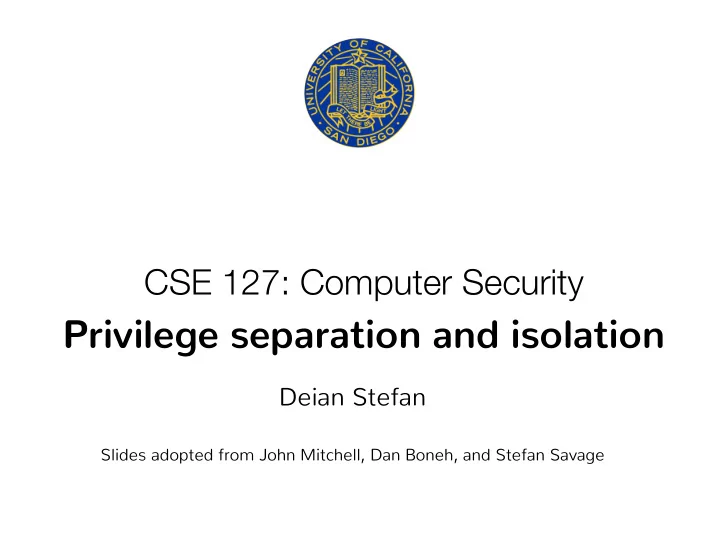

CSE 127: Computer Security Privilege separation and isolation Deian Stefan Slides adopted from John Mitchell, Dan Boneh, and Stefan Savage
Chromium security architecture • Browser ("kernel") ➤ Full privileges (file system, networking) • Rendering engine ➤ Can have multiple processes ➤ Sandboxed • One process per plugin ➤ Full privileges of browser
Privilege separation
Sandboxing/isolation techniques • Layer 1: semantics layer ➤ setuid sandbox, prevent access to most resources • Layer 2: attack surface reduction ➤ seccomp-bpf, prevent access to kernel
setuid sandbox (old) • Creates new network + PID namespace ➤ Why? • Chroot process to empty directory ➤ Why? ➤ E.g., chroot /tmp/guest su guest ➤ open(“/etc/passwd”, “r”) translates to... open(“/tmp/guest/etc/passwd”, “r”);
setuid sandbox (old) • Creates new network + PID namespace ➤ Why? • Chroot process to empty directory ➤ Why? ➤ E.g., chroot /tmp/guest su guest ➤ open(“/etc/passwd”, “r”) translates to... open(“/tmp/guest/etc/passwd”, “r”);
replacement for setuid sandbox • Namespaces (Linux v4) ➤ mnt ➤ pid ➤ net ➤ ipc ➤ user
replacement for setuid sandbox • Namespaces (Linux v4) ➤ mnt ➤ pid + control groups = containers ➤ net ➤ ipc ➤ user
Layer 2 sandbox: seccomp-bpf • seccomp - “secure computing mode” ➤ no sys calls except exit, sigreturn, read, and write to already open FDs • seccomp-bpf - syscall filtering ➤ allow/deny arbitrary set of system calls ➤ filter on syscall arguments • Why do we want this?
How does seccomp-bpf work? • Compile BSD packet filters and load them into the kernel ➤ Why can’t you filter on pointers? ➤ Why do it in the kernel?
More general: syscall interposition • Interpose on system calls ➤ Implement agent that does what you want • Challenges with this approach? ➤ Keeping state synchronized between kernel and agent • How do Firefox and Chrome deal with this? ➤ Not syscall interposition in pure form, but have trusted parent process broker fs, net, etc. access
More general: syscall interposition • Interpose on system calls ➤ Implement agent that does what you want • Challenges with this approach? ➤ Keeping state synchronized between kernel and agent • How do Firefox and Chrome deal with this? ➤ Not syscall interposition in pure form, but have trusted parent process broker fs, net, etc. access
More general: syscall interposition • Interpose on system calls ➤ Implement agent that does what you want • Challenges with this approach? ➤ Keeping state synchronized between kernel and agent • How do Firefox and Chrome deal with this? ➤ Not syscall interposition in pure form, but have trusted parent process broker fs, net, etc. access
• What if we don’t have OS support? • What if we don’t trust the OS to get this right?
Software-based fault isolation • You can use SFI to do whole program isolation ➤ Google’s Native Client did this • But, what was the original motivation behind SFI? ➤ Sandbox modules/make it easy to extend a program with untrusted code
Software-based fault isolation • You can use SFI to do whole program isolation ➤ Google’s Native Client did this • But, what was the original motivation behind SFI? ➤ Sandbox modules/make it easy to extend a program with untrusted code
Software-based fault isolation • Can we just do this with OS process isolation? ➤ A: yes, B: no • What’s the tradeoff? ➤ You often pay context-switch cost ➤ Hot-off-the press: with multiple cores you can get SFI and process-based isolation perf to be on par
Software-based fault isolation • Can we just do this with OS process isolation? ➤ A: yes, B: no • What’s the tradeoff? ➤ You often pay context-switch cost ➤ Hot-off-the press: with multiple cores you can get SFI and process-based isolation perf to be on par
Goals of SFI segment • Confidentiality • Integrity segment • Does it provide availability? ➤ A: yes, B: no
How does it provide C & I? • Rewrite indirect jump, load, and store • Segment matching approach seg 1 ➤ Upside: can pinpoint offending instruction ➤ Downside? seg 2 • Address sandboxing approach ➤ Mask upper bits of target address ➤ Cost?
How does it provide C & I? • Rewrite indirect jump, load, and store • Segment matching approach seg 1 ➤ Upside: can pinpoint offending instruction ➤ Downside? Performance! seg 2 • Address sandboxing approach ➤ Mask upper bits of target address ➤ Cost?
How does it provide C & I? • Rewrite indirect jump, load, and store • Segment matching approach seg 1 ➤ Upside: can pinpoint offending instruction ➤ Downside? Performance! seg 2 • Address sandboxing approach ➤ Mask upper bits of target address ➤ Cost? 2 instructions per store + dedicated registers
How does it provide C & I? seg 1 • Optimized address sandboxing approach ➤ Use register-plus-offset instruction mode seg 2 • What do we need for this to work?
How does it provide C & I? seg 1 • Optimized address sandboxing approach ➤ Use register-plus-offset instruction mode seg 2 • What do we need for this to work?
Are we done? ➤ A: yes, B: no
Need to mediate syscalls This is super hard to get right in practice!
Google’s Native Client
Summary • Secure design principles ➤ Least privilege + privilege separation + isolation • Different ways to do this with diff tradeoffs: ➤ Use UIDs + namespaces + seccomp-bpf ➤ Use syscall interposition ➤ Use software-fault isolatoin
Recommend
More recommend